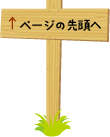Christ lived in Japan?Histry and Legend of Shingo.

Veiled in History and Legend
Older than the Egyptian pyramids,this pyramid dates
back several tens of thousands of years.
Legend has it that Christ was not crucified but lived in the Tohoku region with its abundant nature and romantic history.

ln 1935 rumours suddenly began to
spread from Isohara(present-day
Ibaragi city)in Ibaragi prefecture that
Christ had not in fact been crucified
on the hill of Golgotha,but had travelled secretly to Japan where He lived
to a great age in the village of Herai in
the Tohoku region.
Omaro Takenouchi,a descendant of
Shukune Takenouchi,visited Herai
with Banzan Toya,a researcher in
ancient histoly I and several others
and discovered among the old documents belonging to the Takenouchi
family,ancient writings stating that
Christ had lived in the viilage.Guided
by Denjiro Sasaki,the headman of
the village at the time,they found the
two mounds in the midst of a bamboo
thicket on the to of a small hill.The
mound on the right'Juuraizuka',was
taken to be the grave of Christ and the
moundon the left,‘Judaibo',that of
His brother,Isukiri.
Then on 26 May l936 Christ's will
was discovered by a team of archeologists from an intenational society
for the research of ancient literature.
The village was also mentioned in
‘Light From The East',written by archeological geologist,Kiku Yamane,
and the mystery surrounding the village came to attract many people.
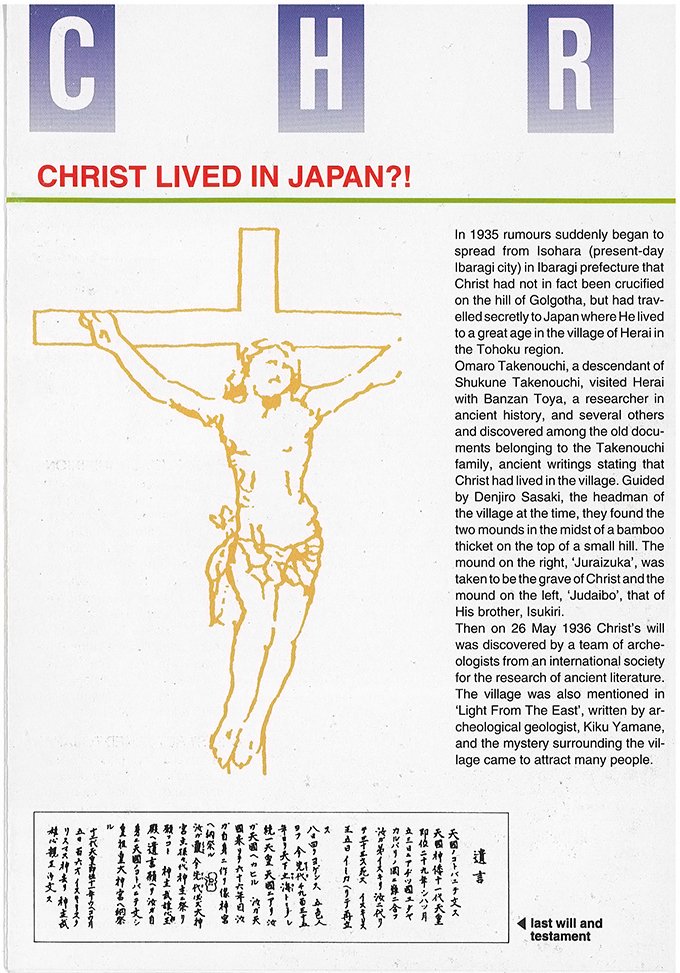
CHRlST CAME TO JAPAN
Christ was born in Judea on the shores of the Mediterranean and lived with his parents in Egypt.On returning to Judea,He grew up in a remote part of Nazareth,but His whereabouts from the age of 21 until He suddenly reappeared at 33 are not known. He preached about Heaven and taught about the existence of God,but the Bible says nothing about what He was doing during those missing 11 years.However,Christ's will tell us in detail how He spent those years.
CHRIST
The Legend of Daitenku Taro Jurai
Christ first came to Japan in the reign of the 11th Emperor,Suinin,landing at the port o fHashidate on the Japan Sea coast,Arriving in the province of Etchu,He became a disciple of a distinguished person living in the region at the time and spent His time studying Japanese language,literature and various other subjects.
At the end of the 11 years,Christleft Japan,now aged 33,landed in Morocco and retumed to Judea, but after His retum He continued to speak about the sacred land of Japan to John the Baptist and the people around Him.
CHRlST FLED CRUClFlXlON
Christ's teachings were not accepted by the Jewish elders of the time,however, and He met with opposition from the Pharisee scholars,Finally He was arrested by the Roman soldiers and condemned to be crucified. However,according to His will,it was His brother,Isukiri,who was nailed to the closs and died in His place.It was not Christ,but His brother who uttered the sorrowful cry in the Bible, ‘My God,why have You forsaken me?'Saved from clucifixion,Christ fled to Siberia with several of His disciples and went in to hiding.
CHRlST RETURNED TO JAPAN
Christ travelled from place to place in the wildemess of Siberia,suffering hardship and privation,and in the fourth year,on 26 Feblruary,He boarded a ship from Alaska,landing at Hachinohe in Aomori prefecture. In Japan,Chlrist changed His name to Daitenku Taro Jurai and settled down in Herai village in the Tohoku region. He took a Japanese woman called Miyuko as His wife and they had three daughters.

CUSTOMS AND PRACTICES LINKED TO JUDEA
CHRIST−Customs and practices handed down to today
CUSTOMS AND PRACTlCES SlMILAR TO THOSE IN JUDEA

Just as Herai,the name of the village, is said to be a distortion of the word ‘Hebrew,,many customs and manners which appear to be related to Judea can still be found today. For example, the word for father is ‘Aya,or‘Dada'and the word for mother is‘Aba'or'Gaga'.Other customs include drawing across on a child's forehead when it is taken outside for the first time after birth,or licking your finger and drawing a cross on your forehead when your legs become numb from sitting,If you do this three times,the numbness will go away. Such customs have been passed down through the ages and the present elders of the village,now in their 80s,learned them as children.
JURAlZUKA AND JUDAlBO
Legend says that Christ passed away in Herai village at the age of 1O6. According to His will,His body was exposed to the wind and rain on Mt. Herai which rises to a height of 1,159m about sixteen kilometers west of the village,and then His bones were buried four years later. The burial took place on the top of a small hill which overlooks the village where there are two mounds,each surmounted by a white cross.The cross on the right is said to mark Christ's grave and is in scribed with the words‘Juraizuka'from Christ's Japanese name which was Daitenku Taro Jurai?.The cross on the left, called 'Judaibo',is where the ear of His brother,lsukiri?,and the hair of the Virgin Mary which He took with Him when He fled crucifixion,are said to be buried.
STAR OF DAVlD
The crest of the Sawaguchi family on whose I and Christ's grave is located is in the shape oft he Star of David (King of Judea)and can be seen nailed to the old shutter box.
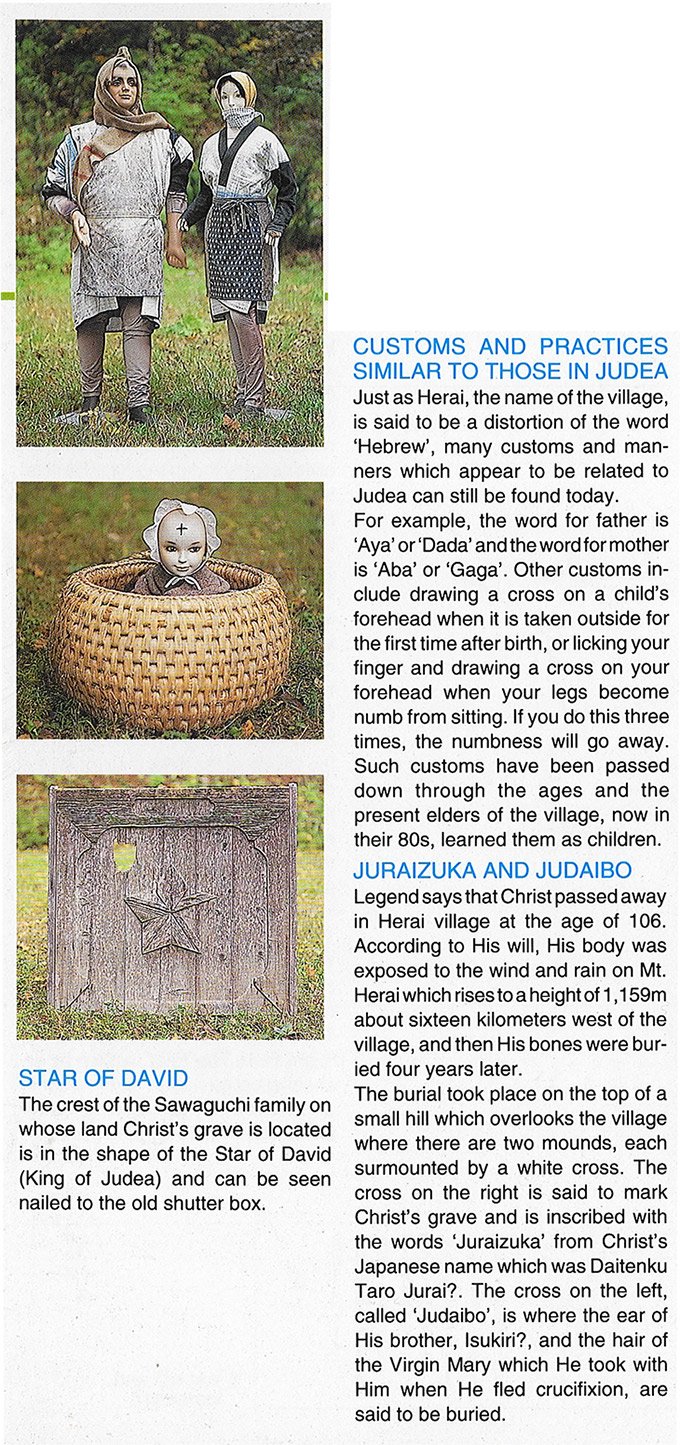
CHRIST'S TRAVELS
According to His last will,Christ settled
in the village of Herai、Although no
longer engaged in missionaly work,
He travelled around Japan,endeavoring to save the common people,
while observing the language,customs and manners of the various regions.
At that time Christ was grey
haired and rather bald with a ruddy
complexion and high nose and wore a
coat with many folds,causing people
to hold him in awe as a long-nosed
goblin.
NANYADOYARA(Bon Festival Dance and Song)
The village's Bon Festival dance and
Song have also been handed down
from ancient times,The song that is
sung atO-Bon and the festival at the
local shrine that is held later goes likethis:
Nanyadoyara-
Nanyadonasareno
Nanyadoyara-
The words do not sound like Japanese
at all,but Dr.eiji Kawamorita,a Doctor of Divinity,who was born in Ichinohe in Iwate
prefecture but now
lives in Seattle,heard the song on a
visit to Japan and translated it asfollows:
We praise your name
You drove away the outsiders
We praise your name.
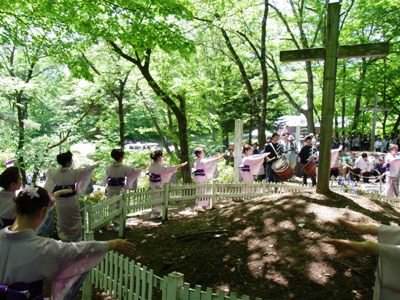

OISHIGAMI PYRAMID
Fourth Pyramid located in Japan
For ancient people the sun was the greatest thing that existed.To get as close as they could to the sun,they built altars in high places and prayed there.
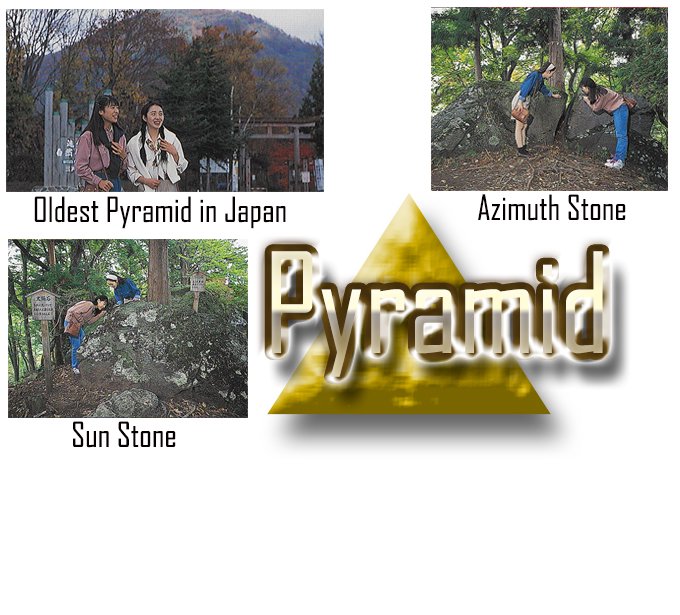
OISHIGAMI PYRAMID IS OLDER THAN THE EGYPTIAN PYRAMIDS
According to the history of the Divine Age found in the documents belonging to the Takenouchi family,there are seven pyramids in Japan, dating back tens of thousands of years and older than the Egyptian pyramids.In 1935 the Japanese artist,Banzan Toya,visited Herai and was dekighted to have found the fourth pyramid. Katsutoki Sakui further discovered the 'Mirror Stone'a massive rock with a base circumference of 12m,the ‘Azimuth Stone' with ameter-long crack that shows precisly tje direction of east and west, and the megalith on the peak shich faces the North Star and accurately shows the direction of north.Legend has it that the Mirror Stone used to stand upright and had writing engraved on it,but it fell over during the earthquake that occurred on July 23,1857 and became embedded in the ground.There is a small shrine there and it is throught that people of old built an altar and prayed there,or else climbed up there on occasion as part of their ascetic practis.The Edgar brothers from England established that it was used for worshipping the sun.
MEGALITH STILL POSES RIDDLE IN MODERN,SCIENTIFICALLY ADBANCED TIMES
According to Ktsutoki Sakai,Japanese pyramids were not built from a flat base like the pyramids of Egypt or Mexico,but were on the top of mountains shapedlike triangles,with fuge rocks arranged around the Sun Stone.The day after the discovery of Christ's grave in Herai in August 1935,the Mt.Towari pyramid was discovered.Oishigami Pyramid is associated with Mt.Towari and is said to have played arole as a place for worshipping the sun from ancient times.
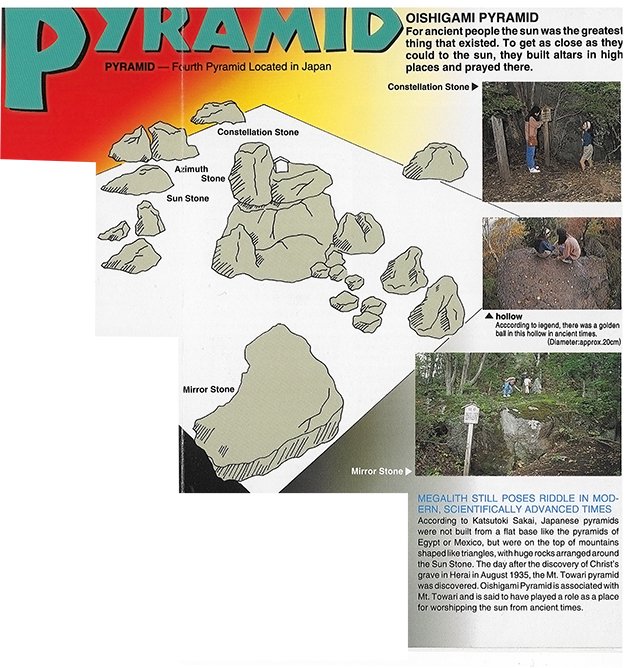

Shingo
An area rich in natutal beauty,full of history and legend.
■ INFORMATION ■
Shingo Business and Tourist Section,Shingo Tourist
Association and Shingo Priducts Association
10 herai Furomae,Shingo-mura,Snnnohe-gune,Aomori-ken 039-1801
Tel.0178-78-2111 Fax.0178-78-2118
Magimptao Green Park Administration Office
11-2 Herai Amaike,Shingo-mura,Snnnohe-gun,Aomori-ken 039-1801
Tel.0178-78-3333 Fax.0178-78-3387














